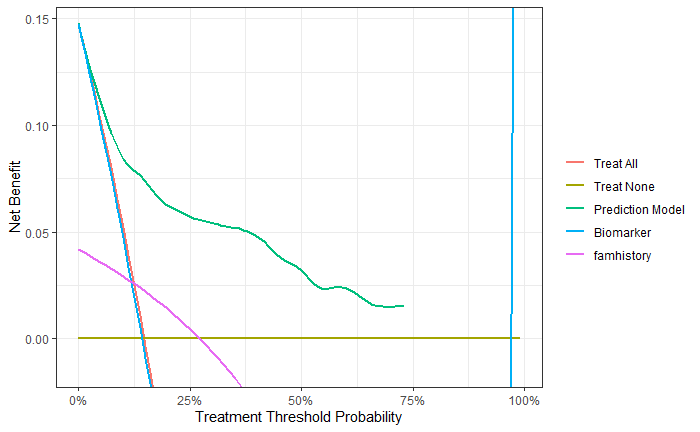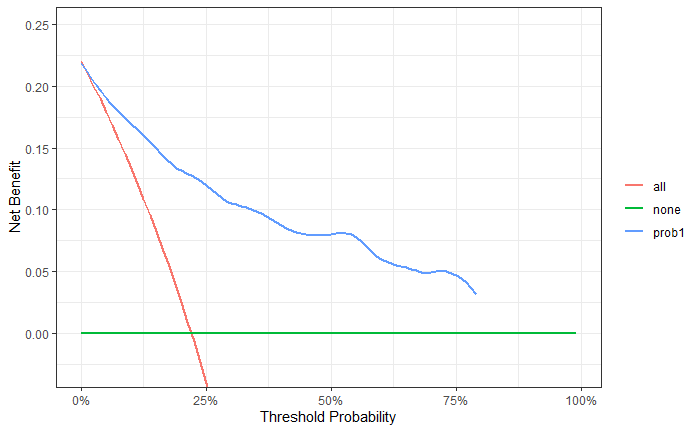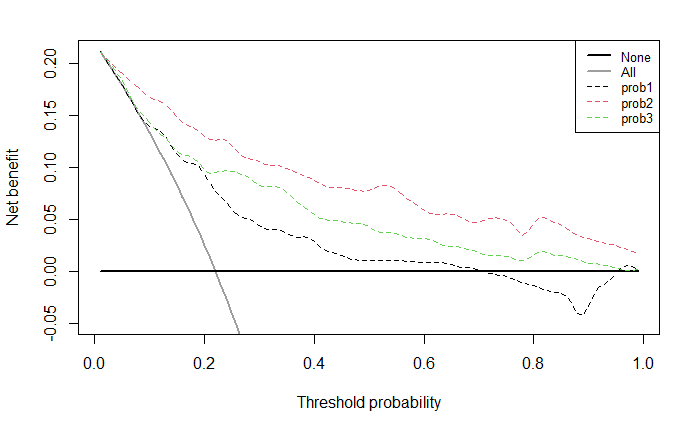生存资料决策曲线分析DCA
本文首发于公众号:医学和生信笔记
“医学和生信笔记,专注R语言在临床医学中的使用,R语言数据分析和可视化。主要分享R语言做医学统计学、meta分析、网络药理学、临床预测模型、机器学习、生物信息学等。
前面介绍了logistic回归的DCA的5种绘制方法,今天学习下cox回归的DCA绘制方法。也是有多种方法可以实现,但我比较推荐能返回数据,用ggplot2自己画的那种。
- 生存资料的DCA
- 方法1
- 方法2
- 方法3
- 方法4
生存资料的DCA
方法1
使用dcurves包,使用的数据集是包自带的df_surv数据集,一共有750行,9列,其中ttcancer是时间,cancer是结局事件,TRUE代表有癌症,FALSE代表没有癌症。
并不是只有结局事件是生存或者死亡的才叫生存资料哦!只要是time-event类型的,都可以。
# 加载R包和数据,不知道怎么安装的请看我前面的推文
library(dcurves)
library(survival)
data("df_surv")
# 查看数据结构
dim(df_surv)
## [1] 750 9
str(df_surv)
## tibble [750 × 9] (S3: tbl_df/tbl/data.frame)
## $ patientid : num [1:750] 1 2 3 4 5 6 7 8 9 10 ...
## $ cancer : logi [1:750] FALSE FALSE FALSE FALSE FALSE FALSE ...
## $ ttcancer : num [1:750] 3.009 0.249 1.59 3.457 3.329 ...
## $ risk_group : chr [1:750] "low" "high" "low" "low" ...
## $ age : num [1:750] 64 78.5 64.1 58.5 64 ...
## $ famhistory : num [1:750] 0 0 0 0 0 0 0 0 0 0 ...
## $ marker : num [1:750] 0.7763 0.2671 0.1696 0.024 0.0709 ...
## $ cancerpredmarker: num [1:750] 0.0372 0.57891 0.02155 0.00391 0.01879 ...
## $ cancer_cr : Factor w/ 3 levels "censor","diagnosed with cancer",..: 1 1 1 1 1 1 1 2 1 1 ...
这个包使用起来很别扭,但是可以说它很灵活!
如果预测变量只有1个,且是0,1表示的,那就很简单,直接用就行;如果有多个预测变量,就需要先计算出预测概率,然后才能使用。
预测变量是famhistory,这是0,1表示的二分类变量:
library(ggplot2)
dcurves::dca(Surv(ttcancer, cancer) ~ famhistory,
data = df_surv,
time = 1 # 时间选1年
) %>%
plot(smooth = T)
 unnamed-chunk-2-146299048
unnamed-chunk-2-146299048
下面展示一个把多个模型的DCA画在一起的例子,和之前介绍的dca.r的用法优点类似。
cancerpredmarker这一列已经是概率了,marker是数值型的连续性变量,famhistory是0,1表示的二分类变量。
dcurves::dca(Surv(ttcancer, cancer) ~ cancerpredmarker + marker + famhistory,
data = df_surv,
as_probability = "marker", # 只有marker需要转换成概率
time = 1,
label = list(cancerpredmarker = "Prediction Model", marker = "Biomarker")) %>%
plot(smooth = TRUE,show_ggplot_code = T) +
ggplot2::labs(x = "Treatment Threshold Probability")
## # ggplot2 code to create DCA figure -------------------------------
## as_tibble(x) %>%
## dplyr::filter(!is.na(net_benefit)) %>%
## ggplot(aes(x = threshold, y = net_benefit, color = label)) +
## stat_smooth(method = "loess", se = FALSE, formula = "y ~ x",
## span = 0.2) +
## coord_cartesian(ylim = c(-0.0147287067742928, 0.147287067742928
## )) +
## scale_x_continuous(labels = scales::percent_format(accuracy = 1)) +
## labs(x = "Threshold Probability", y = "Net Benefit", color = "") +
## theme_bw()
 image-20220620205335965
image-20220620205335965
可以看到marker这个曲线有点过分了。。结果也给出了ggplot2的代码,大家可以自己修改。
上面是多个模型在同一个时间点的DCA曲线,如果是同一个模型在不同时间点的DCA,这个包不能直接画出,需要自己整理数据,因为不同时间点进行治疗的风险和获益都是不一样的,所以会出现同一个阈值概率对应多个净获益的情况,所以none和all每个概率阈值下都有1套数据。
如果你的预测变量是多个,就需要先计算预测概率。
# 构建一个多元cox回归
cox_model <- coxph(Surv(ttcancer, cancer) ~ age + famhistory + marker, data = df_surv)
# 计算1.5年的概率
df_surv$prob1 <- c(1-(summary(survfit(cox_model, newdata=df_surv), times=1.5)$surv))
# 我们分2步,先获取数据,再用ggplot2画图
x1 <- dcurves::dca(Surv(ttcancer, cancer) ~ prob1,
data = df_surv,
time = 1.5
)%>%
dcurves::as_tibble()
# 使用自带的画图代码
ggplot(x1, aes(x=threshold, y=net_benefit,color=variable))+
stat_smooth(method = "loess", se = FALSE, formula = "y ~ x", span = 0.2) +
coord_cartesian(ylim = c(-0.03, 0.25)) +
scale_x_continuous(labels = scales::label_percent(accuracy = 1)) +
labs(x = "Threshold Probability", y = "Net Benefit", color = "") +
theme_bw()
 image-20220620205451700
image-20220620205451700
大家还可以根据自己的喜好继续调整细节。
方法2
使用ggDCA包。是这么多方法里面最简单的一个。对于同一个模型多个时间点、同一个时间点多个模型,都可以非常简单的画出来。
还是使用dcurves里面的df_surv数据集作为演示。
library(ggDCA)
##
## Attaching package: 'ggDCA'
## The following object is masked from 'package:dcurves':
##
## dca
# 建立多个模型
cox_fit1 <- coxph(Surv(ttcancer, cancer) ~ famhistory+marker,
data = df_surv)
cox_fit2 <- coxph(Surv(ttcancer, cancer) ~ age + famhistory + marker, data = df_surv)
cox_fit3 <- coxph(Surv(ttcancer, cancer) ~ age + famhistory, data = df_surv)
多个模型同一时间点的DCA:
df1 <- ggDCA::dca(cox_fit1, cox_fit2, cox_fit3,
times = 1.5 # 1.5年,默认值是中位数
)
library(ggsci)
ggplot(df1,linetype = F)+
scale_color_jama(name="Model Type",labels=c("Cox 1","Cox 2","Cox 3","All","None"))+
theme_bw(base_size = 14)+
theme(legend.position = c(0.8,0.75),
legend.background = element_blank()
)
## Warning: Removed 498 row(s) containing missing values (geom_path).
 image-20220620205523093
image-20220620205523093
同一个模型多个时间的DCA:
df2 <- ggDCA::dca(cox_fit2,
times = c(1,2,3)
)
ggplot(df2,linetype = F)+
scale_color_jama(name="Model Type")+
theme_bw()+
facet_wrap(~time) # 分面展示,因为不同时间点净获益是不一样的
## Warning: Removed 1689 row(s) containing missing values (geom_path).
 image-20220620205609389
image-20220620205609389
多个模型多个时间点:
df3 <- ggDCA::dca(cox_fit1,cox_fit2,cox_fit3,
times = c(1,2,3)
)
#df5 <- as.data.frame(df3)
ggplot(df3,linetype = F)+
scale_color_jama(name="Model Type")+
theme_bw()+
facet_wrap(~time)
## Warning: Removed 1226 row(s) containing missing values (geom_path).
方法3
使用这个网站[1]给出的stdca.r文件绘制cox的DCA,需要代码的直接去网站下载即可。
数据还是用df_surv数据集。
rm(list = ls())
library(survival)
library(dcurves)
data("df_surv")
# 加载函数
source("../000files/stdca.R") # 原函数有问题
# 构建一个多元cox回归
df_surv$cancer <- as.numeric(df_surv$cancer) # stdca函数需要结果变量是0,1
df_surv <- as.data.frame(df_surv) # stdca函数只接受data.frame
cox_model <- coxph(Surv(ttcancer, cancer) ~ age + famhistory + marker, data = df_surv)
# 计算1.5年的概率
df_surv$prob1 <- c(1-(summary(survfit(cox_model, newdata=df_surv), times=1.5)$surv))
# 这个函数我修改过,如果你遇到报错,可以通过添加参数 xstop=0.5 解决
stdca(data=df_surv,
outcome="cancer",
ttoutcome="ttcancer",
timepoint=1.5,
predictors="prob1",
smooth=TRUE
)
 image-20220620205725890
image-20220620205725890
多个模型在同一个时间点的DCA画法,和第一种方法很类似,也是要分别计算出每个模型的概率。
# 建立多个模型
cox_fit1 <- coxph(Surv(ttcancer, cancer) ~ famhistory+marker,
data = df_surv)
cox_fit2 <- coxph(Surv(ttcancer, cancer) ~ age + famhistory + marker, data = df_surv)
cox_fit3 <- coxph(Surv(ttcancer, cancer) ~ age + famhistory, data = df_surv)
# 计算每个模型的概率
df_surv$prob1 <- c(1-(summary(survfit(cox_fit1, newdata=df_surv), times=1.5)$surv))
df_surv$prob2 <- c(1-(summary(survfit(cox_fit2, newdata=df_surv), times=1.5)$surv))
df_surv$prob3 <- c(1-(summary(survfit(cox_fit3, newdata=df_surv), times=1.5)$surv))
# 画图
stdca(data=df_surv,
outcome="cancer",
ttoutcome="ttcancer",
timepoint=1.5,
predictors=c("prob1","prob2","prob3"),
smooth=TRUE
)
 image-20220620205746692
image-20220620205746692
方法4
返回画图数据,再用ggplot2画图:
cox_dca <- stdca(data = df_surv,
outcome = "cancer",
ttoutcome = "ttcancer",
timepoint = 1.5,
predictors = c("prob1","prob2","prob3"),
smooth=TRUE,
graph = FALSE
)
library(tidyr)
cox_dca_df <- cox_dca$net.benefit %>%
pivot_longer(cols = c(all,none,contains("sm")),names_to = "models",
values_to = "net_benefit"
)
使用ggplot2画图:
library(ggplot2)
library(ggsci)
ggplot(cox_dca_df, aes(x=threshold,y=net_benefit))+
geom_line(aes(color=models),size=1.2)+
scale_color_jama(name="Models Types",
labels=c("All","None","Model1","Model2","Model3"))+
scale_x_continuous(labels = scales::label_percent(accuracy = 1),
name="Threshold Probility")+
scale_y_continuous(limits = c(-0.05,0.2),name="Net Benefit")+
theme_bw(base_size = 14)+
theme(legend.background = element_blank(),
legend.position = c(0.85,0.75)
)
## Warning: Removed 83 row(s) containing missing values (geom_path).
 image-20220620205809541
image-20220620205809541
常见的DCA方法都展示了,现在基本都是针对logistic或者cox的,大家自己选择使用哪个就好。
本文首发于公众号:医学和生信笔记
“医学和生信笔记,专注R语言在临床医学中的使用,R语言数据分析和可视化。主要分享R语言做医学统计学、meta分析、网络药理学、临床预测模型、机器学习、生物信息学等。
参考资料
[1]dca.r: https://www.mskcc.org/departments/epidemiology-biostatistics/biostatistics/decision-curve-analysis
本文由 mdnice 多平台发布
